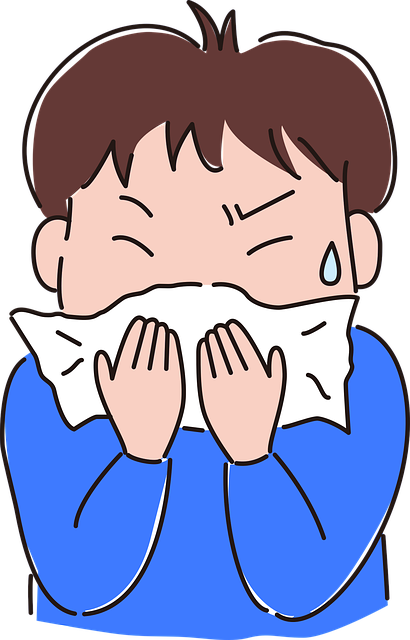9 Most Common Food Allergies + Sx and Tx
Common food allergies are widespread.
Studies suggest that an estimated 33 million Americans have food allergies, roughly 1 in 10 adults and 1 in 13 children. The exact prevalence of food allergies in America varies depending on the study, but there is no doubt that the numbers are staggering and growing and it may or may not be the same in Palm Springs, CA.
This throat health blog post delves into the most common food allergies, symptoms, risk factors, and treatments.

- New Report Says Your Brain Could Be the Key to Reducing Phlegm Over 50
- Doctor's "Leave The Throat Phlegm Behind" Tutorial Goes Viral With People Over 50
- Can You Relieve Throat Phlegm and Coughing In 60 Seconds A Day? This Doctor Says Yes
- How To Banish Phlegm When 50+ (Do This Every Day)
Key Takeaways
- Food allergies are a common issue, affecting an estimated 33 million Americans.
- The most common food allergies are cow’s milk, eggs, peanuts, tree nuts, soybeans, shellfish, wheat, fish, and sesame.
- There is no cure for food allergies. The only treatment is to avoid consuming the foods that trigger an allergic reaction. If you have a severe food allergy, your healthcare provider may prescribe epinephrine auto-injectors to carry with you at all times in case of accidental ingestion.

Understanding Food Allergies in Palm Springs, California
In the vibrant city of Palm Springs, California, renowned for its scenic landscapes and thriving community, the topic of food allergies remains ever relevant. An estimated 33 million Americans suffer from food allergies, posing significant health challenges that can affect anyone, irrespective of age or background.
1. Prevalence of Food Allergies
Food allergies are a widespread issue that impacts millions nationwide, including residents and visitors of Palm Springs. This condition affects approximately 10% of the adult population in the U.S., highlighting the importance of awareness and proper management.
2. Common Food Allergens
The most frequently encountered food allergies include:
– Cow’s milk
– Eggs
– Peanuts
– Tree nuts
– Soybeans
– Shellfish
– Wheat
– Fish
– Sesame
These allergens are responsible for the majority of allergic reactions in both children and adults, necessitating cautious dietary scrutiny.
3. Management and Treatment
Currently, there is no cure for food allergies. The primary management strategy is avoidance of the allergenic foods. In Palm Springs, restaurants and food service establishments are increasingly aware of the importance of catering to customers with food allergies, often offering allergen-free menus or clear labeling of potential allergens.
For those with severe allergies, carrying an epinephrine auto-injector, commonly known as an EpiPen, is crucial. This device can be a lifesaver in the event of accidental ingestion of an allergen, leading to anaphylaxis—a potentially life-threatening reaction.
Local Resources in Palm Springs
Palm Springs hosts several resources for individuals dealing with food allergies:
– Medical Facilities: Facilities like Desert Regional Medical Center offer emergency treatment and allergist services to manage severe allergic reactions.
– Community Support: Local support groups provide a platform for sharing experiences and advice on dealing with food allergies, enhancing community coping strategies.
So What Now?
Living with food allergies in Palm Springs requires vigilance and proactive management, but with the right knowledge and resources, individuals can lead safe and fulfilling lives. Whether you’re dining out or cooking at home, understanding and communication are key to navigating food allergies effectively.
This blog post integrates the factual elements of food allergies with local context relevant to Palm Springs, California, providing useful information that can help individuals manage their conditions effectively while enjoying what the city has to offer.
What is a Food Allergy?
A food allergy occurs when the immune system mistakenly identifies specific food proteins as a threat and attacks them.
When your body is exposed to what it thinks is a harmful substance, it triggers an allergic reaction and activates various protective measures. One of these measures is the release of histamine and other chemicals that cause inflammation.
Symptoms of a Food Allergy
Food allergy symptoms can include:
- Facial swelling, including the mouth
- Itchy mouth
- Tongue swelling
- Trouble breathing
- Low blood pressure
- Hives
- Itchy skin rash
- Wheezing
- Diarrhea
- Vomiting
- Nasal congestion
- Dizziness

Symptoms of a food allergy can occur within minutes to days after exposure, depending on the type.
For certain people, a food allergy can trigger a severe allergic reaction called anaphylaxis (1). This prompts the immune system to release a surge of chemicals that can result in shock, putting the person in danger of life-threatening and potentially deadly symptoms like:
- Rapid pulse
- Shortness of breath
- Swelling of the throat and tongue
- Low blood pressure
- Itch skin rash
- Nausea
- Vomiting
Anaphylaxis is a severe allergic reaction that can occur within seconds or minutes of exposure to an allergen and requires immediate treatment with an epinephrine injection. Failure to treat it promptly can lead to death.
Common Food Allergies vs Food Intolerances
As noted above, a food allergy triggers a harmful immune response to specific proteins in fCow’sood.
By contrast, food intolerances or sensitivities are when your digestive system has difficulty digesting specific foods.
Food intolerances are often confused with food allergies. While it’s true that food intolerance can cause distressing symptoms and significantly impact the quality of your life, it does not involve the immune system and is, therefore, not life-threatening.
The 9 Major Common Food Allergies
There used to be eight foods known to be major allergens. Now, according to the U.S. Food and Drug Administration (FDA), the following 9 foods cause 90 percent of food allergies (2).

Cow’s Milk
When someone has a milk allergy, their immune system overreacts to the proteins found in milk, namely casein and whey.
It is important to note that this is not the same as lactose intolerance, which is the inability to digest lactose products.
Milk is a common food allergy among children in the United States. Approximately 20% of American children with a food allergy are allergic to milk, and almost a third of them experience severe allergic reactions to it at some time in their childhood (3).
According to studies, half of all children outgrow their milk allergy by age five, and 75 percent tolerate milk proteins by the time they reach adolescence (4).
A milk allergy in adults is much less common than in children.
If you or your child has been diagnosed with a milk allergy, the only treatment option is to abstain from consuming cow’s milk and foods that contain it. These foods include:
- Milk
- Milk powder
- Cheese
- Butter
- Margarine
- Yogurt
- Ice cream
- Cream

Eggs
Did you know that egg allergy is the second most prevalent cause of food allergy in children, affecting around 2.5 percent of them (5)?
However, some good news is that 68 percent of children with an egg allergy will likely outgrow it by the time they reach 16 years old (6).
It’s important to note that you can be allergic to the egg white, the egg yolk, or the whole egg. Experts suggest avoiding the entire egg if you have an allergy.
Like other food allergies, the only treatment for an egg allergy is to avoid consuming eggs and any food product made with eggs.
Fortunately, the FDA has made determining if processed foods contain eggs easier. The Food Allergen Labeling and Consumer Protection Act (FALCPA) mandates that manufacturers include the term “egg” on the product label whenever any form of egg is present (7). So, you must always check the ingredient label of a food product for any traces of egg.
It is important to note that some vaccines, like those for the flu and MMR (measles, mumps, and rubella), may contain egg protein. If you have an egg allergy, it is recommended that you speak with your healthcare provider to weigh the potential risks and benefits of getting vaccinated.

Peanuts
It’s important to note that peanut allergies are common and can result in severe and “ potentially fatal allergic reactions. Anaphylaxis rates are higher for peanut allergies than for milk, egg, or wheat allergies.
Peanuts belong to the legume family, which includes soybeans, peas, lentils, and beans. The protein in peanuts is similar to tree nuts, so having a peanut allergy also increases the likelihood of having a tree nut allergy and vice versa. However, being allergic to peanuts does not necessarily mean you are allergic to other legumes like soybeans, peas, or lentils.
It’s worth noting that peanut allergies typically last a lifetime. Even small amounts of peanut protein can trigger an allergic reaction, so it’s crucial to read food labels carefully and ask about the ingredients used. Look for phrases like “contains peanut” or “made on shared equipment with peanuts” on food labels, especially high-risk foods like baked goods and candy. Cross-contamination is possible in these items, even if peanuts are not listed as an ingredient (8).
Tree Nuts
A tree nut allergy is an allergic reaction to certain nuts and seeds obtained from trees. It is a commonly occurring food allergy, affecting approximately 1% of the population in the United States and up to 3% worldwide (9, 10).
People who have an allergy to tree nuts are also allergic to food items made from them, like nut butter and oils. It is recommended that they stay away from all kinds of tree nuts, even if they are only allergic to one or two types. This is because having an allergy to one type of tree nut raises the likelihood of developing an allergy to other kinds (11).
Tree nuts include:
- Cashews
- Walnuts
- Macadamia nuts
- Almonds
- Brazil nuts
- Pine nuts
Unlike some other allergies, tree nut allergy is usually a lifelong condition and can be severe. In fact, tree nut allergies account for around 50 percent of anaphylaxis-related deaths (12, 13). Therefore, people with nut allergies and other potentially life-threatening allergies are advised to carry an epinephrine auto-injector, such as EpiPen, at all times.
This device is life-saving, allowing those with allergies to inject themselves with a shot of adrenaline if they experience a severe allergic reaction. Adrenaline is a hormone that naturally stimulates the body’s “fight or flight” response during stressful situations. When given as an injection to individuals experiencing a severe allergic reaction, it can reverse the effects of the allergy and save their lives (14).

Soybeans
Soy is a prevalent food allergy among children but less common among teenagers and adults. It is estimated that approximately 0.4 percent of children are allergic to soy.Approximately 50 percent of children are believed to outgrow their soy allergy after one year, and most will outgrow it by the time they reach 10 years of age (15).
While allergic reactions are generally mild, severe and life-threatening reactions can occur with all food allergies.
Food and beverages that contain soy include:
- Tofu
- Infant formula
- Canned tuna
- Sauces
- Miso
- Tempeh
Soy must be labeled on food packages, so read all food labels before purchasing if you or your child have a soy allergy.

Shellfish
A shellfish allergy is caused by your body attacking proteins from the crustacean and mollusk families of fish known as shellfish.
Popular types of shellfish include:
- Shrimp
- Lobster
- Scallops
- Squid
Seafood allergy is often triggered by a protein called tropomyosin. However, other proteins, such as arginine kinase and parvalbumin, may also contribute to an immune response (16, 17).
Symptoms of a shellfish allergy usually manifest quickly. However, distinguishing a true seafood allergy from an adverse reaction to seafood contaminants like bacteria, viruses, or parasites can be difficult. Both can cause digestive problems such as vomiting, diarrhea, and stomach pain.
Since shellfish allergy doesn’t usually resolve over time, most individuals with the condition must avoid all shellfish to prevent allergic reactions (18).
Interestingly, even the vapors from cooking shellfish can trigger a shellfish allergy in people who are allergic. As a result, it’s often advised that they avoid being near seafood when it’s being cooked (19).

Wheat
An allergic reaction to a wheat protein causes a wheat allergy, which should not be confused with celiac disease. Celiac disease is an autoimmune condition that causes damage to the small intestine after consuming gluten. However, gluten is usually not involved in wheat allergy reactions.
While wheat allergies are common in children, they are rare in adults, with only 0.4% of children in the United States suffering from this condition. Furthermore, two-thirds of the children outgrow that allergy by age 12 (20).
Some children with a wheat allergy could also be allergic to other grains. However, many substitute different types of grains to meet their nutritional needs. Consult an allergist to ensure that other grains like amaranth, barley, or rye are safe to consume.
If you have a wheat allergy, you must check all food labels, even if you think it does not contain wheat.
Wheat can be found in many foods and beverages, including:
- Pasta
- Sauces
- Bread
- Deli meats
- Ice cream
- Cereals
Fish
It is common for people to have fish allergies, which can affect up to 7% of adults (21). This type of allergy can develop during childhood (22), but it is not uncommon for it to appear later in life (23).
Like shellfish allergies, fish allergies can also cause severe and potentially fatal reactions, including vomiting, diarrhea, and anaphylaxis in rare cases. That’s why individuals allergic to fish usually carry an epinephrine auto-injector in case of accidental ingestion.
It’s important to note that shellfish and fish with fins do not carry the same proteins, so someone allergic to shellfish may not necessarily be allergic to fish. However, many people with a fish allergy are allergic to one or more types of fish.
Sesame
Did you know that sesame was not considered a significant food allergen until recently? The Food Allergy Safety, Treatment, Education, and Research (FASTER) Act, which became law in 2021, recognized sesame as the ninth major food allergen (24).
Per FALCPA guidelines, food manufacturers must now list sesame as an ingredient on product labels. This change will be effective from January 1, 2023 (25).
Sesame is a common allergen, with around 17% of children with food allergies being allergic to it. Unfortunately, only 20% to 30% of children outgrow their sesame allergy (26). Like other major allergens, sesame contains proteins that can trigger an immune reaction in allergic individuals.
Despite being an allergen, sesame is a key ingredient in many international cuisines, including Chinese, Japanese, African, and American foods.
What to Do if You Think You Have a Food Allergy
It can be challenging to distinguish between food allergies and food intolerances. If you suspect that you have a food allergy, it is crucial to consult with a doctor. The doctor will likely recommend various diagnostic tests to determine if you have a food allergy or intolerance, including:
- Recording your dietary and medical history. Both will help the healthcare provider decide whether you’re likely to have food allergies.
- Blood tests, to check antibodies
- Skin prick test, to monitor the skin for possible allergic reactions
- Oral food challenge, which involves eating certain foods slowly, in gradually increasing amounts, under the supervision of a medical professional to see if an allergic reaction occurs. This is usually the last step in confirming a food allergy diagnosis and is typically done after the blood or skin prick test.
Food Allergy Treatments
It is currently impossible to cure food allergies. The best way to prevent an allergic reaction is to identify the foods that trigger your allergies and avoid consuming them.
If your food allergy is severe, your healthcare provider may prescribe medications such as epinephrine auto-injectors, which you should carry with you at all times in case of accidental ingestion (27). Epinephrine is particularly effective in reversing the symptoms of a severe allergic reaction known as anaphylaxis. Popular brands of epinephrine auto-injectors include EpiPen and Auvi-Q.
Your doctor may also recommend antihistamines to help reduce itching and congestion caused by less severe allergic reactions or corticosteroids for reducing inflammation in more severe cases. These drugs are available by prescription and over the counter.
If you suspect a food allergy, it is important to consult a doctor or allergist to determine the specific allergen and make a plan to avoid it. Additionally, meeting with a registered dietitian can help you safely avoid allergenic foods while maintaining a balanced and nutritious diet.
Summary
Most food allergens are contained in nine foods: cow’s milk, eggs, peanuts, tree nuts, soybeans, shellfish, wheat, fish, and sesame.
Unlike food intolerances, food allergies are caused by your immune system incorrectly identifying some of the proteins in food as harmful.
Food allergies can cause life-threatening reactions and require complete avoidance of the allergen.
If you suspect a food allergy, speak with a doctor about it.
Frequently Asked Questions
What are 3 signs and symptoms of a food allergy
Three common signs of a food allergy are the following:
- Facial swelling, including the tongue and mouth
- Trouble breathing
- Hives
Does Benadryl help with food allergies?
Yes. If you’re experiencing mild symptoms such as a runny nose, itchy mouth, mild itching, or slight stomach discomfort, Benadryl (diphenhydramine) may be able to provide relief. Make sure to carefully read and follow all instructions on the label to ensure proper use.
What are the major food allergens?
There used to be 8 foods known to be major allergens. Now, according to the U.S. Food and Drug Administration (FDA), 9 foods cause 90 percent of food allergies:
- Cow’s milk
- Eggs
- Peanuts
- Tree nuts
- Soybeans
- Shellfish
- Wheat
- Fish
- Sesame
Can a food allergy go away on its own?
People who have food allergies often question if their condition is permanent. The answer to this is not clear-cut. Allergies to milk, eggs, wheat, and soy may fade away with time, whereas allergies to peanuts, tree nuts, fish, and shellfish are usually lifelong.
What is oral allergy syndrome?
Oral allergy syndrome (OAS) is a food allergy triggered by specific pollens and foods associated with those pollens. It is also known as Pollen Food Allergy Syndrome.

- New Report Says Your Brain Could Be the Key to Reducing Phlegm Over 50
- Doctor's "Leave The Throat Phlegm Behind" Tutorial Goes Viral With People Over 50
- Can You Relieve Throat Phlegm and Coughing In 60 Seconds A Day? This Doctor Says Yes
- How To Banish Phlegm When 50+ (Do This Every Day)
References
1- https://pubmed.ncbi.nlm.nih.gov/32550734/
2- https://www.fda.gov/food/food-labeling-nutrition/food-allergies
3- https://linkinghub.elsevier.com/retrieve/pii/S1081120613001403
4- https://www.mdpi.com/2072-6643/11/5/1051
5- https://pubmed.ncbi.nlm.nih.gov/32376485/
6- https://pubmed.ncbi.nlm.nih.gov/32376485/
7- https://pubmed.ncbi.nlm.nih.gov/24505841/
8- https://www.foodallergy.org/living-food-allergies/food-allergy-essentials/common-allergens
9- https://pubmed.ncbi.nlm.nih.gov/32044450/
10- https://pubmed.ncbi.nlm.nih.gov/26233427/
11- https://pubmed.ncbi.nlm.nih.gov/28836701/
12- https://pubmed.ncbi.nlm.nih.gov/31018893/
13- https://pubmed.ncbi.nlm.nih.gov/20645999/
14-https://pubmed.ncbi.nlm.nih.gov/32001253/
15- https://www.ncbi.nlm.nih.gov/pubmed/25459576
16- https://pubmed.ncbi.nlm.nih.gov/29858102/
17- https://pubmed.ncbi.nlm.nih.gov/31950908/
18- https://pubmed.ncbi.nlm.nih.gov/27404324/
19- https://pubmed.ncbi.nlm.nih.gov/26252073/
20- https://www.foodallergy.org/living-food-allergies/food-allergy-essentials/common-allergens
21- https://pubmed.ncbi.nlm.nih.gov/27613460/
22- https://pubmed.ncbi.nlm.nih.gov/30741635/
23- https://pubmed.ncbi.nlm.nih.gov/15241360/
24- https://www.foodsafety.gov/blog/food-allergy-safety-treatment-education-and-research-act-2021
25- https://www.foodsafety.gov/blog/food-allergy-safety-treatment-education-and-research-act-2021
Dr. Matthew Olesiak, MD, is the Chief Medical Director at SANESolution, a renowned wellness technology company dedicated to providing evidence-based solutions for optimal living. Dr. Olesiak earned his medical degree from the prestigious Jagiellonian University Medical College in Kraków, Poland, where he developed a strong foundation in medicine.


